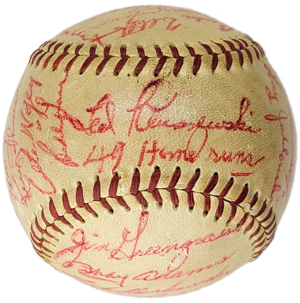

During his time with the Macon Peaches, Kluszewski showcased the raw power and batting consistency that would later define his career in the majors. His imposing physical presence and disciplined approach at the plate caught the attention of scouts and coaches alike. This period not only provided him the opportunity to develop his skills but also solidified his reputation as a hitter capable of both high average and power production.
Ted Kluszewski's journey to Major League Baseball began in the late 1940s, as a raw yet talented first baseman for the Macon Peaches, a minor league affiliate of the Cincinnati Reds in the Southeastern League. Coming out of a standout athletic career at Indiana University, where he excelled in both football and baseball, Kluszewski's talent was undeniable. It was with the Macon Peaches that he first gave professional baseball a glimpse of the prodigious power that would soon define his career.
In Macon, Kluszewski displayed remarkable batting skills, combining strength and precision. Even as a young player, he showed the rare ability to hit for both power and average—an attribute that would become his hallmark. His muscular build was unusual for a baseball player in the 1940s, and he quickly became known for his imposing stature at the plate.
Though official statistics from his time with the Peaches are harder to come by, reports from that era suggest Kluszewski’s natural ability to drive the ball to all parts of the park was evident early on. His time in Macon served as a crucial developmental stage, where he refined his mechanics and approach to hitting. It wasn’t long before his performance caught the attention of the Cincinnati Reds, who saw in Kluszewski a future star.
Ted Kluszewski made his major league debut for the Cincinnati Reds in 1947, and it didn’t take long for him to make an impact. While his first few seasons were spent adjusting to major league pitching, by 1950, Kluszewski had established himself as a premier hitter in the National League. Known for his broad shoulders and massive arms, Kluszewski famously cut off the sleeves of his uniform because they were too tight, a move that not only set a trend but also showcased his impressive physique.
Kluszewski's power numbers began to surge in the early 1950s, and he quickly became one of the most feared hitters in baseball. Between 1953 and 1956, he was one of the most dominant power hitters in the game:
1953: 40 home runs, 108 RBIs, .316 batting average
1954: 49 home runs, 141 RBIs, .326 batting average
1955: 47 home runs, 113 RBIs, .314 batting average
1956: 35 home runs, 102 RBIs, .302 batting average
During these peak years, Kluszewski was a four-time All-Star (1953-1956) and led the Reds in nearly every offensive category. His ability to hit home runs with minimal strikeouts was especially impressive. In an era where strikeouts were common among sluggers, Kluszewski struck out only 40 times in 1955 while hitting 47 home runs, a testament to his incredible hand-eye coordination and plate discipline.
Legendary Power and Precision
What set Kluszewski apart wasn’t just his raw power, but his ability to hit for average as well. Unlike many power hitters who struggled with consistency, Kluszewski maintained a batting average over .300 during his prime. His controlled, level swing allowed him to make solid contact on nearly every swing, resulting in fewer strikeouts and more opportunities for RBIs.
He was also known for his meticulous approach to hitting. Kluszewski studied pitchers closely, understanding their tendencies and adjusting his strategy accordingly. His physical strength enabled him to drive the ball with authority to all fields, making it difficult for defenses to shift on him effectively.
Impact on Baseball and Influence Off the Field
Kluszewski's popularity wasn’t just due to his on-field prowess. Fans admired his work ethic and quiet leadership. Although he wasn’t a vocal leader, his presence in the clubhouse was undeniable, and younger players often looked up to him. Off the field, he was known as a gentle giant, often spending time signing autographs for fans and engaging with the community.
His fashion-forward decision to alter his uniform by cutting off the sleeves led to a new look for sluggers, with many others following suit in later years. More importantly, it symbolized his larger-than-life presence in the game, as well as his unique understanding of how to play the game his way.
Later Career: Pittsburgh Pirates, Chicago White Sox, Los Angeles Angels
Following his stellar years with the Reds, Kluszewski's career took him to the Pittsburgh Pirates (1958-1959), Chicago White Sox (1959), and the Los Angeles Angels (1961). While injuries hampered his later seasons, Kluszewski was instrumental in helping the Chicago White Sox win the 1959 American League pennant. He hit .391 with 3 home runs in the 1959 World Series, though the White Sox eventually lost to the Los Angeles Dodgers.
He ended his career in 1961 with the newly formed Los Angeles Angels, where he provided veteran leadership and helped establish the franchise during its inaugural season.
After retiring as a player, Kluszewski returned to the Reds organization, serving as a hitting coach and mentor to younger players. His knowledge of the game and ability to teach the fundamentals of hitting made him a valuable asset in player development. Kluszewski’s influence extended far beyond the field, as he became a respected figure in the Cincinnati baseball community.
Ted Kluszewski passed away in 1988, but his legacy lives on as one of the most iconic power hitters of the 1950s. His career totals include:
Home Runs: 279
RBIs: 1,028
Career Batting Average: .298
Though injuries shortened what could have been an even more prolific career, Kluszewski remains a symbol of the Cincinnati Reds’ rich history. His combination of power, precision, and professionalism set a standard for future generations of sluggers, and he will forever be remembered as one of baseball’s true greats.
#MACONPEACHES | EMAIL US